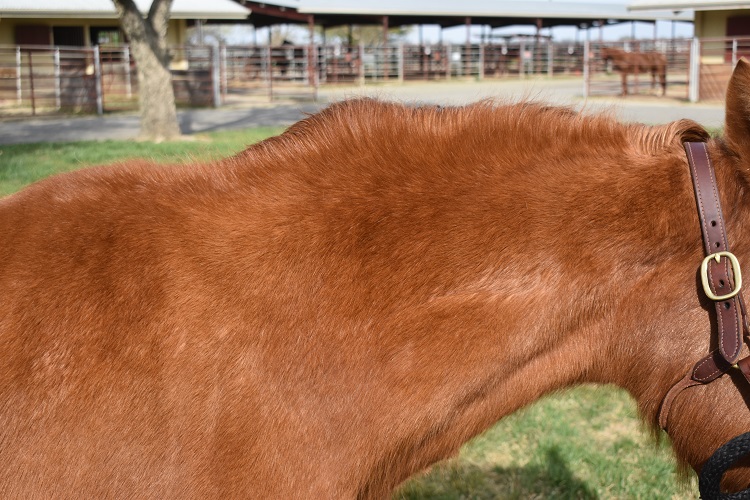Separate But Connected - Endocrine Diseases EMS, PPID, and Laminitis
Equine metabolic syndrome (EMS), pituitary pars intermedia dysfunction (PPID) and laminitis are associated with disruptions in the equine endocrine system. They are discrete conditions, but can occur at the same time in an individual animal. Treatment for all three involves diet and exercise management.
Equine Metabolic Syndrome

Equine metabolic syndrome is associated with inappropriate blood insulin levels(insulin dysregulation), increased fat deposition, and a reduced ability to lose weight. When affected horses consume meals high in specific carbohydrates, their bodies produce higher than normal levels of insulin and are slow to return to baseline values.
This disorder often affects horses bred to survive in harsh climates, including ponies, Arabians and mustangs. These breeds utilize glucose very efficiently to ensure adequate energy reserves when food is scarce. When these “thrifty” horses have access to an abundance of carbohydrates and do not get as much exercise as they would in their ancestral habitats, they consume too many calories. One of the most serious consequences of EMS is laminitis.
Treatment for EMS is with dietary management in the form of non-structural carbohydrate restriction, calorie restriction, and a reduction or elimination of pasture access. It may also include increased exercise depending on physical condition and soundness.
Many horses respond well to management through diet and exercise. Horses that are “easy-keepers”or have persistently high insulin levels may require medical treatments. Although treatment can reduce clinical signs, there is no “cure” for EMS. Long-term care requires diligence along with support and guidance from a veterinarian.
Pituitary Pars Intermedia Dysfunction (PPID)
Pituitary pars intermedia dysfunction, also known as Cushing’s Disease, causes progressive degeneration of neurons in the brain as horses age, resulting in production of high levels of hormones such as adrenocorticotrophic hormone (ACTH) and cortisol. Clinical signs include a long, curly hair coat, delayed shedding, loss of muscle, and laminitis. Horses with PPID can be susceptible to infections and abscesses, have decreased wound healing, and have higher parasite burdens.

To date, aging is the only significant risk factor for PPID and cases typically occur in horses older than 15 years of age. Approximately 30% of horses with PPID also show signs of insulin dysregulation, the hallmark of EMS. Knowledge of insulin status is important for assessing laminitis risk and informing dietary management.
There is no cure for PPID. Treatment is intended to reduce clinical signs and must be continued for the life of the animal. The only medication licensed for the treatment of PPID in horses is pergolide mesylate (Prascend®). Some horses respond to a low level of medication, while others need a much higher level. Earlier diagnosis may result in a better quality of life, particularly if negative consequences like infections and laminitis can be avoided.
Management also involves a veterinarian-approved diet and exercise program. Horses with PPID should receive good preventative veterinary care to ensure they are healthy due to a decrease in their immune responses. This includes a regular deworming and vaccination protocol, routine dental examination, and periodic blood work.

Laminitis
Laminitis is damage and inflammation of the tissue between the hoof and the underlying coffin bone (distal phalanx, P3). This tissue, the laminae (also called lamellae), is actually folded layers of tissue, contacting the surface of the bone on one side and the inside of the hoof wall on the other, connecting the two. Depending on how severely these attachments are weakened, the outcome can range from mild foot soreness to separation of the coffin bone and hoof (founder). The front hooves, which bear the majority of the horse’s weight, are most commonly affected, but it can also occur in the hind hooves.

Laminitis can be the outcome of excessive grain intake, access to pasture high in sugars, compensatory weight bearing due to injury of the opposite limb (supporting-limb laminitis), ingestion of toxic plants, and excessive work on hard surfaces (road founder). Laminitis often occurs due to diseases such as EMS or PPID (endocrinopathic laminitis), sepsis or systemic inflammatory response syndrome (sepsis-related laminitis).
Laminitis is irreversible and once clinical signs are observed, the damage is already underway. At this point, it is important to minimize further progression. Treatment largely involves pain management and supportive care. Successful management is dependent upon good relationships between owners, veterinarians, and farriers. Early identification is ideal for recovery. Call your veterinarian immediately if you suspect that your horse is developing laminitis.
